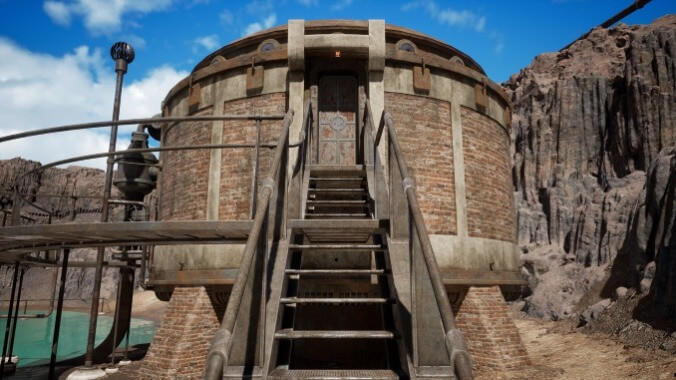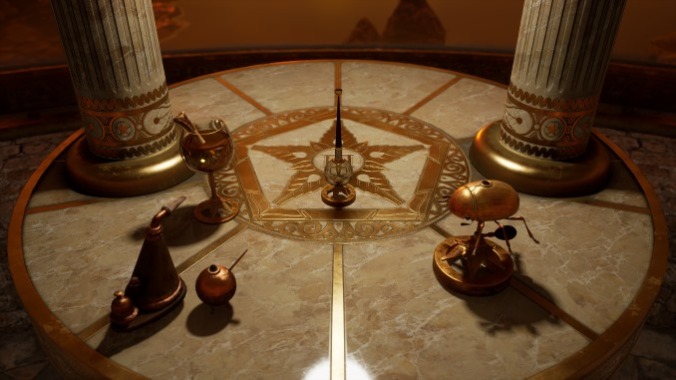
Approaching Riven in 2024 is different from approaching the original in 1997. In 1997, the game was sold in two ways: it was the follow up to the blockbuster puzzle game Myst, and it was using the cutting edge of full-motion video and 3D imaging to convince you that its strange world was living and breathing. It succeeded on both accounts, creating a pillar of the puzzle game genre full of iconic, unique-to-Riven images. In 2024, we are buried in fantastical images at the edge of graphical fidelity, and the puzzle games that Riven spawned are a healthy subgenre. We might wonder, then, what Riven gives to us now.
I am not objective on this issue. I believe that the original Riven is one of the greatest games ever created. I had some apprehension about this new version of the game, given that it was taking a point-and-click game that moved from screen to screen and transforming it into a fully realized 3D world that you might walk around in like you do in Call of Duty. I had a deep fear that seeing the sculpted, and strange, world of Riven from all angles might reduce it in some way, and I had a reason for that fear: Cyan’s 2021 remake of Myst in the same style mangles that game, makes it feel small, and populates it with potato people with the voices of 1990s ghosts.
That is not an issue here. Riven 2024 maintains the reputation of the original while remixing it into something slightly more friendly for modern players. I cannot pay enough compliments to the team at Cyan for threading one of the most difficult needles I can imagine encountering in game design and development. Riven captures the soul of the original and encases it in a more robust game system.

What made the original Riven so special, and what the remake capitalizes on, is that it is a world that has been lived in. This is driven home by the fiction of the Myst franchise—these games are about people who make, or believe they make, worlds. The core drama of Riven centers on Atrus and his father Gehn. As a child, Gehn showed Atrus how they could use the cultural artifacts of the long-dead D’ni civilization to create Ages, entire worlds generated by the writing of a description book that calls them into being. Gehn sees himself as the heir of an empire of worldmakers, and desired to return that civilization to its conquering, godlike status. In the book that sets up Riven, we learn that the core friction between Atrus and Gehn centers on how these two men see the worlds they link to. Gehn understands himself as a creator, where Atrus sees the act of linking as a form of finding preexisting worlds. In the time before the game, Atrus and Gehn link to the Age of Riven, live on the islands, and change them in their image. Atrus falls in love with and marries Catherine, a native of the Age. Riven begins to fall apart, at least partially because of Gehn’s alterations to the world through his power of writing. In the end, as the world seems to be dying, Atrus and Catherine destroy all of the ways off of Riven, escape the Age, and close the door behind them, trapping Gehn forever. Or trapping him until Riven begins.
All of this might seem like meaningless story stuff that exists outside of the hardcore puzzling that Riven is known for. Instead, it is bone-deep necessary for understanding why the world of Riven feels the way it does and why the puzzles of the game work the way they do. This game is lived-in, and not in the way that game discussions talked about the “lived-in” nature of a 3D open world game. Instead, every puzzle you have to solve, every goal you have, every approach you take is based on learning the material relationships between the people of Riven, their overlord Gehn, and his attempts to flee the world and reassert himself as the lord of all creation.
Take, for example, one of the core puzzles of Riven. There are puzzles that have numbers. The numbers used are not Arabic numerals because the people of Riven would have their own numbers. Hold on, though, because that’s not exactly the case. Gehn began colonizing this Age with his writing of the book and more traditional methods once he arrived. That means that some of Riven’s islands, especially where Gehn spends most of his time, have information contained in D’ni numerals, a riff on the Roman system. The schoolhouse of the Rivenese village has an elaborate, instructive toy that shows how these numerals work. At the same time, it seems like Atrus might be correct about how Ages work, because the Rivenese have their own numeral system centered on circular rotation and multiples of three, a system that seems to predate Gehn’s invasion of the island. To learn it, you might have to consult a child’s cheat sheet in school or locations where Gehn’s influence is less felt. And you’ll need this system of equivalency, from D’ni to Rivenese to Arabic numbers, in order to complete the game because you’re navigating systems created by the Rivenese, Gehn, and the game designers who are preparing all of this for us.

The imagination of material history, and how it builds a world, still might be unmatched in a videogame. I cannot think of a single puzzle or system in Riven that does not resolve down into how people in this world live and attempt to accomplish their goals. This was a core value for the original team (I encourage those interested to track down a copy of From Myst to Riven), and it is a value I associate with Richard Vander Wende, the director of the 1997 hit who returned for this remake. This material history isn’t just window dressing, but describes a core struggle happening in the margins of Riven. It is a world that has been invaded by Gehn, had their culture replaced and warped by the magic of his writing, and then been turned into a labor force to help him escape his imprisonment. The Riven we play in is a world at quiet war, with a rebellious group called the Moiety using his powers against him. The actions we take in the game intervene here and ultimately spell the doom or victory of the groups involved.
I think that Riven is worth playing simply as an artifact, something so strange and different from other games that it simply needs to be experienced for the experience, but that isn’t really why most people buy videogames or read reviews. For this remake, it is probably important to note how things have changed. Obviously we have full 3D movement, which generally just allows players a little more freedom to understand how things are related in the world. Some of the puzzles have changed, including the entire structure of the notorious fire marble puzzle near the endgame. I found it much more tolerable here without losing any of the interesting trickery of solving it. There are some substantive changes to how Rivenese culture is materially shown in the world, including some new ways of learning the numbers and symbology of Riven, which I mostly really enjoyed as a way of regrounding the material history of the world that I find so intriguing. There are some new interesting things involving the Starry Expanse that I will not reveal for those who want to experience a little shock. Generally, however, this is Riven, and all the changes that I found felt useful and easy for the sake of story and ease of use. I am sure that purists have opinions.
I enjoyed replaying Riven in remade form, and while I do not think this game replaces the original, it certainly supplements it and makes it more attractive for someone curious about this game and franchise. The puzzles are still good, the alterations are sensible, and the Age of Riven itself remains an enchanting place to piece together.
Riven was developed and published by Cyan Worlds. Our review is based on the PC flatscreen version. It is also available in VR and for Meta Quest.
Cameron Kunzelman tweets at @ckunzelman.